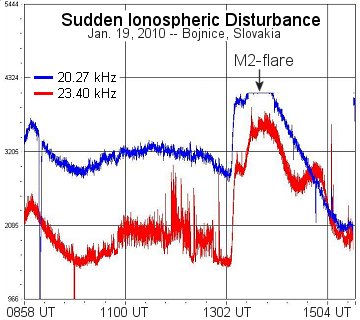For those who saw Michael Jefferson’s talk on his Sudden Ionospheric Disturbance detector at the last meeting (and for those who didn’t) the same apparatus is currently featured on the SpaceWeather web site. There were recently a couple of strong solar flares that showed well on the SID graphs. Nice to see that Mike’s network is getting some publicity. Follow the link below to see the article and graphs. And yes, Mike’s apparatus recorded the same information very well too!
http://www.spaceweather.com/
UPDATE:
The SpaceWeather page has updated to new stories, but here is the text and image from th site:
“IONOSPHERIC DISTURBANCE: An M2-class solar flare on Jan. 19th bathed Earth’s upper atmosphere in X-rays and caused a wave of ionization to sweep over Europe. This improved the propagation of low-frequency radio signals, which use the ionosphere as a reflector to skip over the horizon. A SID monitor operated by Rudolf Slosiar in Bojnice, Slovakia, recorded a surge in signal strength:
“SID” stands for Sudden Ionospheric Disturbance, and a “SID monitor” is a radio receiver that monitors ~20 kHz signals from distant transmitters. “My system clearly detected the effects of the solar flare,” says Slosiar. “The decay of the signal shows that it took about 72 minutes for the ionosphere to recombine [and relax to its pre-flare state].”
With solar activity on the rise, sudden ionospheric disturbances will become more common. Interested? Stanford University tells you how to build your own SID monitor.”

